#Throwback Thursday: The 1985 season in retrospect
On March 3, 1985, the PBA began its second decade of existence minus two of the greatest and most popular teams – the Crispa Redmanizers and the Toyota Tamaraws.
For the first ten seasons featuring 29 conferences, the Redmanizers won 13 championships, the Tamaraws nine, the U/Tex Wranglers, San Miguel Beermen and Great Taste Coffeemakers two apiece while guest team Nicholas Stoodley won one.
For this week’s Throwback Thursday, The Rivalry goes back in time 38 years ago as it features the highlights and lowlights of the PBA on its 11th season.
New team, new venue
Crispa disbanded at the end of the 1984 season and sold its franchise to Shell Chemicals . These were turbulent times – inflation was at an all-time high, there was political turbulence, Marcos’ hidden wealth was exposed, there were protest rallies almost every week. In November 1985, Marcos came out on the talk show, “This Week with David Brinkley” to announce the snap presidential elections to be held on February 7, 1986.
The PBA featured six teams – league pioneers Great Taste Coffee, Magnolia Ice Cream and Tanduay Rhum Makers, along with Ginebra San Miguel, Manila Beer Brewmasters and Shell Azodrin Bugbusters. The NCC national team also played two conferences as part of their preparation for the 1985 ABC tournament slated to be held on December.
It was a pragmatic move on the part of the PBA Executive Committee headed by Commissioner Mariano Yenko and his Deputy, Tommy Manotoc, to shift venues from the 30,000-seating Araneta Coliseum to the newly-built but smaller University of Life Theater and Recreational Arena (now PhilSports Arena) in Pasig City, capable of housing 12,000 fans. The ULTRA provided a different environment but most evident was the arena’s acoustics that made the crowd produce higher decibels.
There was also a stark difference in the location. From the highly-dense and easy-to-get-to Big Dome at the heart of Cubao in Quezon City, the ULTRA was situated at the more isolated Brgy. Oranbo location in Pasig City, around three kilometers away from the nearest main avenue, Shaw Boulevard. Fortunately for the commuting fans, there were jeepneys available from Ortigas Avenue to ULTRA. But for car-riding patrons, they had to park along the road, particularly on the hilly perch of Saint Martin Avenue all the way to Saint Paul, Pasig.
Still, there were positives. The players appreciated the new venue because the facilities were newer and the basketball court more modern. The broadcasters found themselves situated at the lower level section of the arena beside the fans, housed by a glass-protected booth, instead of the typical courtside location near the technical committee. The booth provided a better vantage point, allowing the anchors and analysts to have a better view of the action happening inside the court. Similarly, they were protected from a hail of pelted coins and debris from the crowd when the calls don’t go their team’s ways.
https://rivalrynetwork.com/throwback-thursday-fabled-crispa-redmanizers-disband-after-10-seasons/
Manotoc’s brilliance
Tommy Manotoc has always been a class act – whether as team manager for U/Tex, head coach of the Euyang franchise that won two championships, head coach for the San Miguel Beermen that won a championship, or authoring Crispa’s second grand slam in 1983. But there were three key moves that Manotoc introduced when he took a more active role as Deputy Commissioner.
The first was the distribution of the Crispa players to different teams instead of allowing them to all stay with Shell. Manotoc’s dream has always been to establish league parity, a wish that he always had since he was U/Tex’s manager at the start of the maiden season of the league. Having been with the Wranglers and the Beermen, considered the two next elite teams behind Crispa and Toyota, Manotoc knew the ordeal of having to topple the duopoly. Curiously, in the three titles he won with U/Tex and SMB, two of them were against Crispa and the other one against Toyota. He also experienced handling the powerhouse team, which he led to another Triple Crown. Yet, Manotoc felt that if the league would survive and retain relevance, all teams must be competitive to win championships. Crispa’s disbandment and its players’ dispersal to different teams fast-tracked this process.
The second was the dispersal of the league’s top big men. At that time, the PBA’s top centers were Ramon Fernandez, Abet Guidaben, Philip Cezar and Manny Victorino. Not wanting to give a team an advantage of having two superstar bigs in its fold, Manotoc ordered that these four players were to play for separate teams and barred them from playing together. Hence, Fernandez was with Manila Beer (later Tanduay), Guidaben went to Tanduay (later Manila Beer in a trade with Fernandez), Cezar bannered neophyte team Shell, while Victorino stayed with his first pro team, Great Taste. At the same time, Manotoc also prevented Bogs Adornado, who just left Great Taste, from Robert Jaworski and Ginebra even when the former was about to sign a contract with the Gins. In Episode 100 of the online sports show, “An Eternity of Basketball,” Adornado recalled a phone call being made from the Commissioner’s Office preventing him to sign the contract offered by Ginebra, courtesy of new playing coach Jaworski and his close associate, Bill Warne. “Pipirma na ako, pero biglang may tumawag, sa Commissioner’s Office daw, sabi hindi ako puwede pumasok sa Ginebra.” When asked why, Adornado sheepishly cited, “bawal daw magsama ang dalawang superstars sa isang team.”
The third one was perhaps the then presidential son-in-law’s biggest contribution to the league. He introduced the “no harm, no foul” rule – a concept Manotoc summarized as “unless personal contacts are such that they hinder the natural flow of the game, the game must go on unmolested.” He then rationalized this by adding, “a referee can defang a team, render it helpless, demoralize it by calling fouls needlessly and then hide behind the immunity of judgement calls. Fans come to watch the superstars play, and when these players foul out because of the indiscriminate foul calls,” – Manotoc also wore his manager’s hat in explaining this move – “it would be unfair to team owners paying astronomical salaries to their superstars only to see them not finishing the game because of the referees’ calls.”
The impact was almost immediate. The league eclipsed its 1983 record in terms of gate receipts, earning Php 10.9M from the previous 1983 high of Php 8.34M during the high-flying days of Billy Ray Bates and Crispa. Manotoc acknowledged how fans readily warmed up to the new rule – “this has made the games more exciting, fluid and more like basketball in the sense that there was more continuity and the games were not stopped senselessly by referees’ whistles. As a result, the games were shorter because there were less calls.”
The no harm, no foul rule had its own share of detractors. The most bitter critic was NCC national coach Ron Jacobs, who decried the inconsistency in the way the calls were being made. “The officials are given so much space to make decisions instead of merely calling what they see,” opined Jacobs. Manotoc admitted to the lapses, saying that the referees needed some time to adjust to the new rule. He then committed to upgrade the officiating, a perennial league sore spot, by intensive training and a salary incentive scheme.
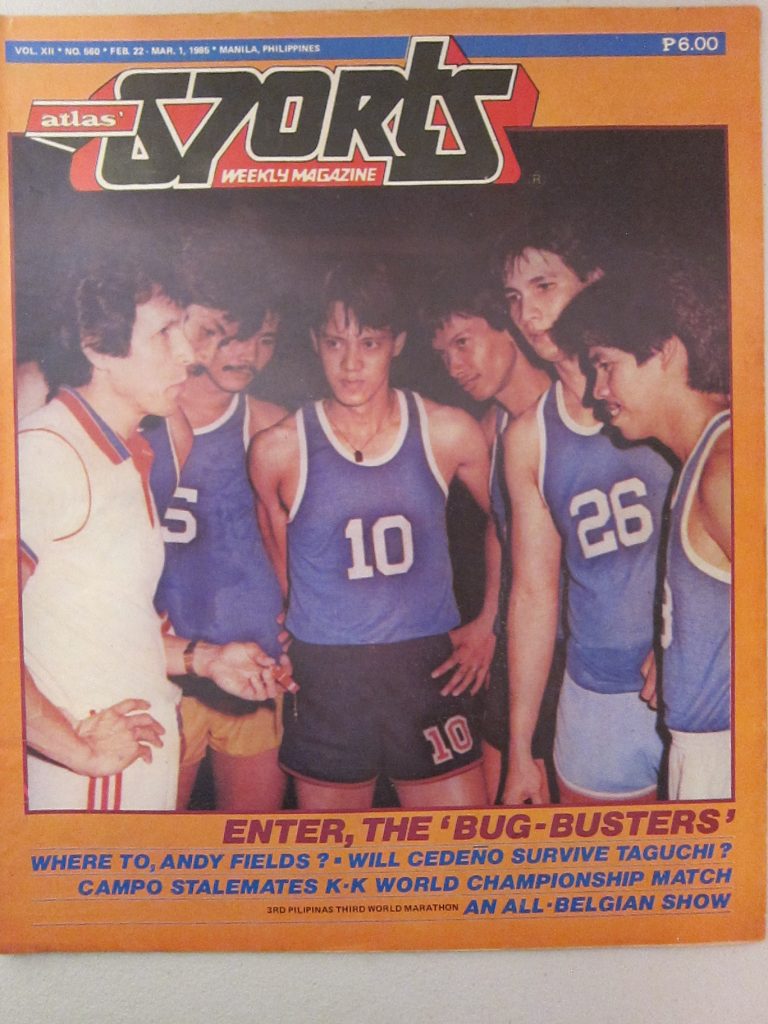
The Open Conference is back
In 1984, there were two All-Filipino conferences that were held, brought about by the country’s economic woes. With attendance significantly dropping, the league opted to bring back imports in the Third Conference (Invitationals) with one import per team no taller than 6’5. To cut down on costs, the Invitationals was held for only one month. Overall, the league suffered a 4.2% drop in attendance in 1984 compared to the previous 1983 season.
Hoping to bring back its luster, the league kicked off the 11th season by featuring one import per team of unlimited height. Ginebra brought in Harold Driver, who turned out to be a dud and was wittingly described by Jaworski as “akala ko driver yun nakuha ko, yun pala, kutsero!” He was replaced by John Campbell. Great Taste paraded Nap Johnson who was replaced by Joe Binion. Magnolia, whose resources were limited as team owner Danding Cojuangco focused more on the national team, brought back their 1982 import, Norman Black, who was also appointed as playing head coach. Manila Beer opted for Doug Harris, but he was subsequently replaced by former Great Taste and Crispa import, Lew Brown, a 6’11 mastodon. Shell ushered in Kevin Graham but eventually replaced him with Rich Adams, a former U/Tex and SMB reinforcement. Finally, Tanduay welcomed Merlin Wilson but replaced him with the charismatic David Pope. Guest team NCC featured their three naturalized players – Dennis Still, Jeff Moore and Chip Engelland – but only two of the three were allowed on the court at the same time.
Great Taste eventually won the championship as the 6’9 Binion proved to be too much for the 6’5 Black. The Coffeemakers won, 4-2, in their best-of-seven series as Ricardo Brown sizzled in Games 5 and 6, scoring 41 and 39 points, respectively, to lead the way.
- Spiking popularity: Comparing volleyball’s following in the Philippines and the US
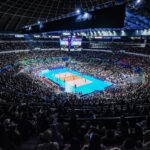
- Cool sweep: How Creamline’s winning formula led to a 7th PVL crown
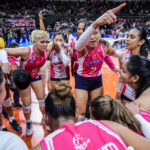
- Pampanga Dragons celebrate 25th anniversary of MBA championship
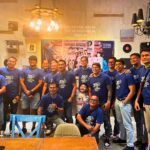
- NBA app launches personalization features, live game experience

- Dante Silverio celebrates 86th birthday in style
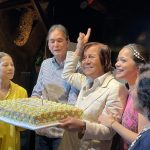
The All Filipino – Great Taste goes back-to-back
There was no doubt in everyone’s mind that the Coffeemakers were the best professional ballclub in the land. After collaring three straight titles, they were odds-on favorites to win their fourth – the All Filipino being a particular favorite for them. Meanwhile, NCC didn’t participate in this conference as they had commitments to play in the World Interclub and the Jones Cup.
It wasn’t even close – their offensive machine blistering in all cylinders, Great Taste rampaged to the Finals with a 12-4 win-loss card, four games ahead of their nearest competitors, Shell and Ginebra. In the battle for the second Finals seat, the Bugbusters defeated the Gins, 89-78 in the knockout game to face GTC for the title.
The championship series showcased the offensive brilliance of Bogs Adornado. The three-time MVP averaged a scintillating 34.5 points per game, only to see his Bugbusters lose out, 3-1, against the heavily-favored Coffeemakers. Adornado waxed hot all series-long, exploding for 46 points in Game 2, but it was GTC’s deep bench and Brown’s sensational all-around game that mitigated the former Crispa stud’s hot performance.
The win gave the Coffeemakers a rare opportunity to match Crispa’s feat of winning the grand slam in one season. The Redmanizers previously accomplished this twice – the first time in 1976 followed by a phenomenal run in the 1983 season. It would also give Baby Dalupan his second grand slam.
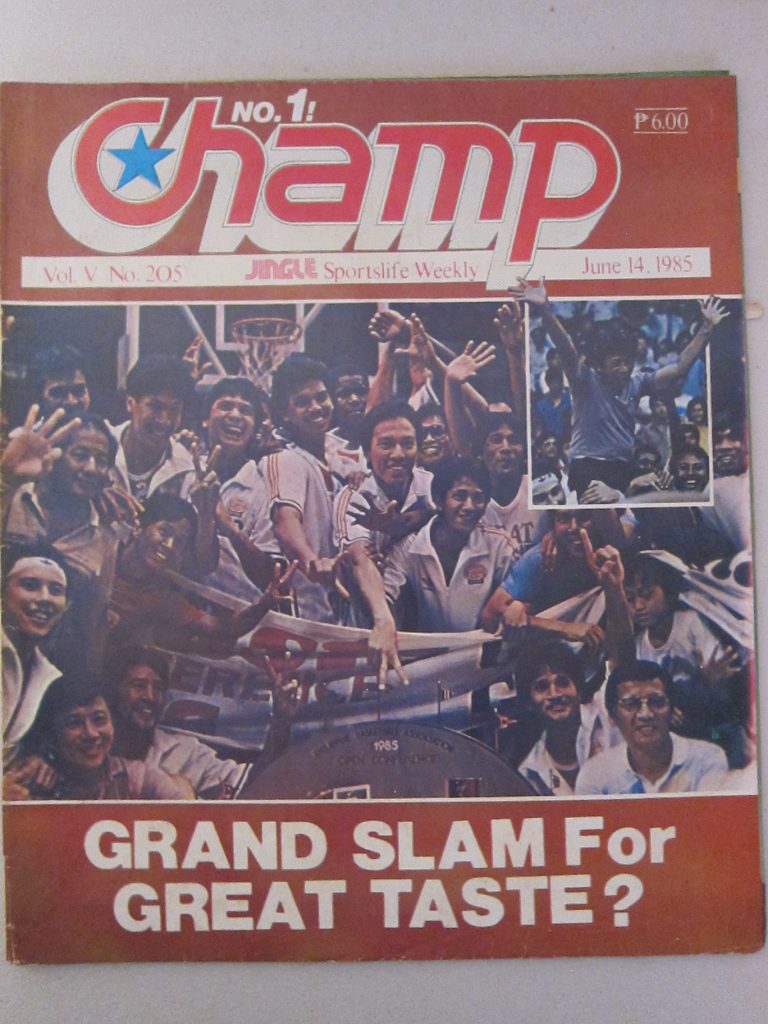
The Reinforced Conference – the Nationals stamp their class
Great Taste was obviously aiming for the triple crown and there was no better way to achieve this with Dalupan at the helm. Unfortunately for them, the team got saddled with import woes – having to change their import twice. Wally Rank first came in and was bruited to be an ideal choice, especially since he was recommended by no less than Brown. Unfortunately, Rank demanded that his salary be paid in advance, a request that was declined by management. He only got to play four games, sat it out for the next two, before being replaced by Michael Britt. Britt, nicknamed “The Flying Pencil,” proved to be ineffective and after four games, was replaced by Corey Blackwell. The former Seattle Supersonic appeared in sync with his teammates in his first few games until a foot injury slowed him down and he couldn’t match his contemporaries like Michael Hackett of Ginebra, Francois Wise of Tanduay, Black of Magnolia and Howard Carter, later replaced by Lester Rowe, of Shell. When the semifinals’ smoke was cleared, the Brewmasters ended up at the top with a 4-2 slate, while the Coffeemakers and the national team were to face each other in a knockout game for the second Finals seat.
The nationals unleashed their deadly fangs against the hapless Coffeemakers in the KO game, demolishing them 123-107 to set up a Best of 7 series against the Brewmasters. But while the locals of the Brewmasters were playing beautiful music with Wise, who previously played for U/Tex and Tanduay in the previous seasons, NCC was reaching its peak. The nationals, which didn’t suit up Engelland in the third conference since he wouldn’t be suiting up in the ABC tournament in Kuala Lumpur in December, had more than enough weapons to create a huge wedge between them and the Lucio Tan-owned franchise. The result was total annihilation – the nationals swept Manila Beer, 4-0, winning by an average margin of 25.5 points per game. To date, this remains the most lopsided championship series in PBA history. More importantly, it also established NCC as the best ballclub in the country, making them more than worthy representatives of the Philippines in the forthcoming ABC meet. On January 4, 1986, the nationals likewise swept the ABC tournament, defeating six teams on its way to regaining the title it last won in 1973 in Manila.
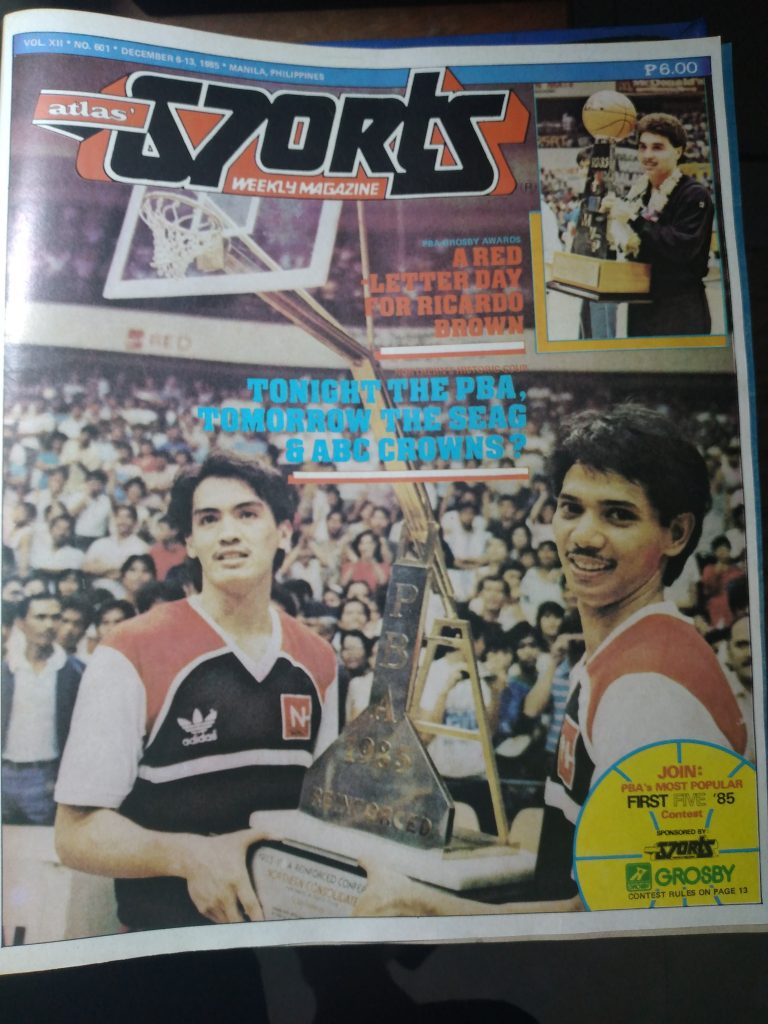
Individual Awards – Brown runs away with MVP plum
No one would argue with the choice of The Quick Brown Fox winning the MVP award for the season. He had a dominant season – 27.9 points per game, including a game high of 57 points, while shooting 48.4% in 2-point FG’s, 82.8% in FT%, and a sizzling 42.8% from beyond the arc. He also tallied 3.66 rebounds, 9.09 dimes and 1.4 swipes a game. Joining him in the Mythical First Team were teammates Victorino and Pearson, Shell’s Adornado and Tanduay/Manila Beer’s Guidaben. The Second Team featured Fernandez, Generalao of Tanduay, Cezar of Shell, Abe King of Great Taste and Jaworski of Ginebra.
It wasn’t like Brown’s 1985 performance was unexpected. When the former Pepperdine U standout joined the PBA in 1983, he was not just the Rookie of the Year, but also became the second freshman after Arnie Tuadles to crack the Mythical First Team. While Guidaben had an undisputed MVP season, Brown was one of the runners-up. The season after, he was also runner-up to Fernandez for the top individual prize. Buoyed by the two championships of Great Taste in 1985, there was no denying Brown taking home the prize.
Post-mortem
1985 was a critical year for the PBA, and the league responded well. Gate receipts were at an all-time high, surpassing their 1983 performance while their TV ratings and advertising revenues soared to higher levels. It was evident that the league was able to survive its first major challenge of losing Crispa and Toyota to disbandment.
Prior to the start of the third Conference, Manila Beer’s Fernandez and Tanduay’s Guidaben were traded for one another in what is now called “The First Trade.” Another trade emerged three years after between the same personalities with Guidaben moving to Purefoods while Fernandez ending up with San Miguel.
But perhaps the biggest single event for the year was that a new crowd darling emerged midway through the third conference as Ginebra San Miguel, on October 22, 1985, showcased their unrelenting spirit in the famous “birth of never-say-die” game against NCC. Jaworski came back after receiving nine stitches in his upper lip to carry his Gins to a resounding, breakthrough and, yes, historic win against the Jacobs-mentored team, 99-96. The game captured the collective imaginations of the basketball fans, and made Ginebra the most popular team in the country even up to today.
